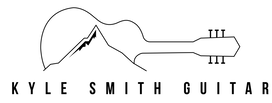 Learning how to use guitar scales is an important part of learning to play guitar. Scales provide a path towards improving your finger coordination while opening doors to learning more about music theory, learning songs by ear, and playing guitar solos. Musically speaking, there is no difference in scales played on the guitar, and scales played on any other instrument. Physically, the mechanics of the instrument dictate how the scale is played. With guitar scales, we are looking at finger patterns that can be used to play a specific scale at different points on the neck. Typically these finger patterns are what we call movable patterns - you can move them up or down the guitar neck and be able to play the same type of scale (and the same pattern) from different starting notes.
0 Comments
 Arpeggio patterns are a useful skill for any guitar player. These patterns help you outline chords in your solos, improve your technical skills, and can help you master the guitar fretboard as you learn them. Dominant 7th is the full name of a chord quality that you are probably already familiar with, whether you realize it or not. A G dominant 7th chord symbol would be G7. Most of us have learned these simply as "7th chords" - I'm going to be a little more specific in this lesson because there are different types of "7th chords" that you might learn later on. With arpeggio patterns, you are playing the notes from a chord one at a time - almost like a scale pattern. If you play a G7 arpeggio, you are playing a G7 chord in a way that you can use for playing melodies, riffs, or guitar solos. These arpeggio patterns will challenge your fingers to move in new ways, adding a new layer to your technical skills and abilities. By playing these arpeggio patterns from different starting notes on each string, you can play in any key, anywhere on the guitar fretboard. Dominant 7th arpeggio patterns are found in many musical styles, including jazz, rock, blues, country, and other popular styles. No matter what kind of music you want to play, these arpeggio patterns will come in handy.  Major scales are important for all guitar players to learn. These patterns form the foundation of our musical system - knowing your major scales will open up many more possibilities for what you are able to play and understand in music. For guitar players, knowing how to play major scales can help you master the fretboard, play by ear, and develop your technique. Most of our music theory works in relation to the major scale, so working with these patterns will give you the tools you need so you can understand music better, and communicate with other musicians. These scales are important for every style, and if you want to learn to play jazz guitar, learning your major scales is an essential first step. Note: this is the fifth article in a short series designed to help you play your guitar more often, because the more you play your guitar, the better you'll get! If you haven't already, check out part 1, part 2, part 3, and part 4 of this series. 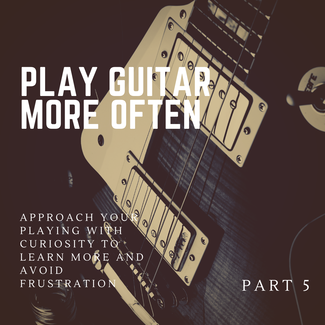 Earlier in this series, we looked at various techniques you can use to play your guitar more often. Keeping your guitar on a stand, creating a habit, scheduling your practice time, and playing for fun first are all things that can help you play guitar more often. In this lesson, we're going to work more on your mindset when it comes to practicing guitar. Too often playing guitar can become frustrating (like when you think something should be easier for you to play), or like a chore (like when you're playing through material that is boring for you). One of the best ways to get around feelings of boredom or frustration in your guitar playing is to approach your practice with curiosity. By staying curious and treating your guitar practice as a puzzle to solve, you can keep yourself motivated to pick up your guitar day after day. Note: this is the fourth article in a short series designed to help you play your guitar more often, because the more you play your guitar, the better you'll get! If you haven't already, check out part 1, part 2, and part 3 of this series. 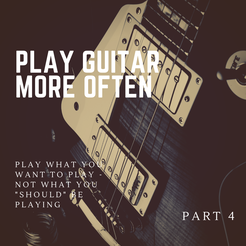 By now we all know that playing guitar more is one of the big hurdles to playing better - you need to spend time on the instrument regularly. So far, we've looked at ways to play more by keeping your guitar visible, creating a habit so you practice automatically, and putting your guitar time on your schedule so you don't miss it These are all good strategies that work for people on their own or in some kind of combination. But sometimes, you just don't want to practice anyway. Maybe you're stressed or excited about something else coming up in your life. Maybe the material from your guitar lesson is a little too hard, or seems boring for you right now. Even if you don't spend a ton of time on your lesson material, some guitar time is always better than no guitar time. Today we're going to look at playing something you really want to play to start off your practice session. This can be a good strategy if you find yourself resisting your practice time. Note: this is the third article in a short series designed to help you play your guitar more often, because the more you play your guitar, the better you'll get! If you haven't already, check out part 1 and part 2. 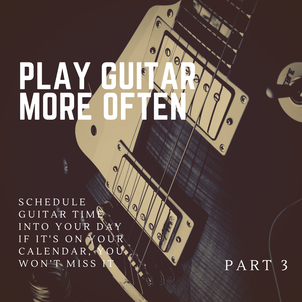 The more you play your guitar, the better you will get. So far in this series we've looked at keeping your guitar on a stand, and building a habit around something else you do on a daily basis. While both of these are great strategies, it's worth developing a wider toolkit for getting your guitar practice in. I've found over the years that it sometimes takes a variety of tools to keep yourself moving forward. Habits may work for a while, but then your schedule changes. You keep the guitar on a stand in your living room, but now it's summer and you're spending your time outside. Whenever one strategy stops helping you play more, you can always change your approach - if you have more than one trick up your sleeve. This lesson will focus on scheduling guitar practice into your day. It can be as simple as a reminder on your phone, or an entry into your calendar app. Just something to give you a little nudge to pick up your guitar. Note: this is the second article in a short series designed to help you play your guitar more often, because the more you play your guitar, the better you'll get! Check out part 1 here. 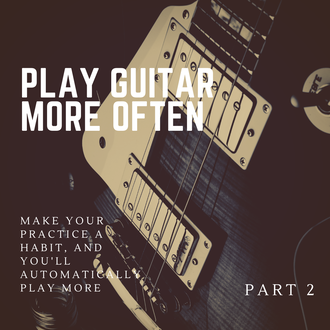 If you want to improve your guitar playing, you need to spend time playing guitar. It seems obvious, but sometimes we need to have these things spelled out for us. In part one of this series, we looked at making your guitar visible so you'll be more likely to pick up your guitar and play it. In this lesson, we are going to explore creating a habit of playing your guitar more often. It takes a little bit of thought and willpower up front, but before too long you'll be picking up and playing your guitar almost automatically each day.  The best guitar players I've met are the ones who play guitar the most. This goes for the professionals I've worked with, and students of mine who have become great players themselves. You don't have to practice for hours at a time to get good at playing guitar. It does help if you play your guitar regularly though. Even a few minutes a day can help you start to improve if you do it often enough. Note: If you want to become a professional, you have to put in the time. There's no way around that - in college, music majors are expected to practice a minimum of 4 hours each day. If you're playing for fun, you'll be surprised at how much you can improve with a little bit of time each day. The biggest hurdle you face in your own guitar playing is making sure you're playing your guitar regularly. Playing for an hour a couple of days out of the week is not going to help you as much as playing guitar for a little bit of time each day. Make it a goal to play guitar on more days than you don't play guitar. (Even if it's just for a couple of minutes - it's worth it) Over the next few weeks, we'll look at some simple ways you can start playing your guitar more regularly. Click the "Read More" button below.  At some point in your jazz guitar playing career, someone is going to ask you to use something called "rootless voicings" for your chords. This is especially true if you're playing in a jazz ensemble or small group at the high school or college level. (If you're playing professionally, you probably already know what rootless voicings are, how to use them, and when to use them in your playing.) The theory here is that if you're playing the root as a part of your chord, it's an unnecessary note because the bass player is playing the root as a part of their bass line. While I don't 100% agree with this idea as a fundamental rule, it's still important for you to learn how to play these rootless chords. You want to be able to do what your director/bandleader/etc asks you to do - it's your job as the guitar player, and they are likely hearing things out front that you are not hearing from your seat by the amplifier. By dropping off the root from your basic jazz guitar chords you open up new possibilities for color, and free up your hands for simpler "grips" on your chords. Even when you're not asked to, experiment with using these chords to see what they sound like in a playing situation. Eventually, you want to be able to decide whether or not to include the root at the bottom of your chord based on the situation (song, style, band, soloist preferences).  Major 7th arpeggios are an important skill for any jazz guitar player to have. Practicing these arpeggio patterns will help you improve your technique in both hands, develop ideas for improvisation, and learn the notes on the guitar neck. You are also training your ears and fingers to find notes that are a part of the major 7th chord - so when you see one written on the page (or recognize the sound when you hear it), your fingers know what to do already. |
